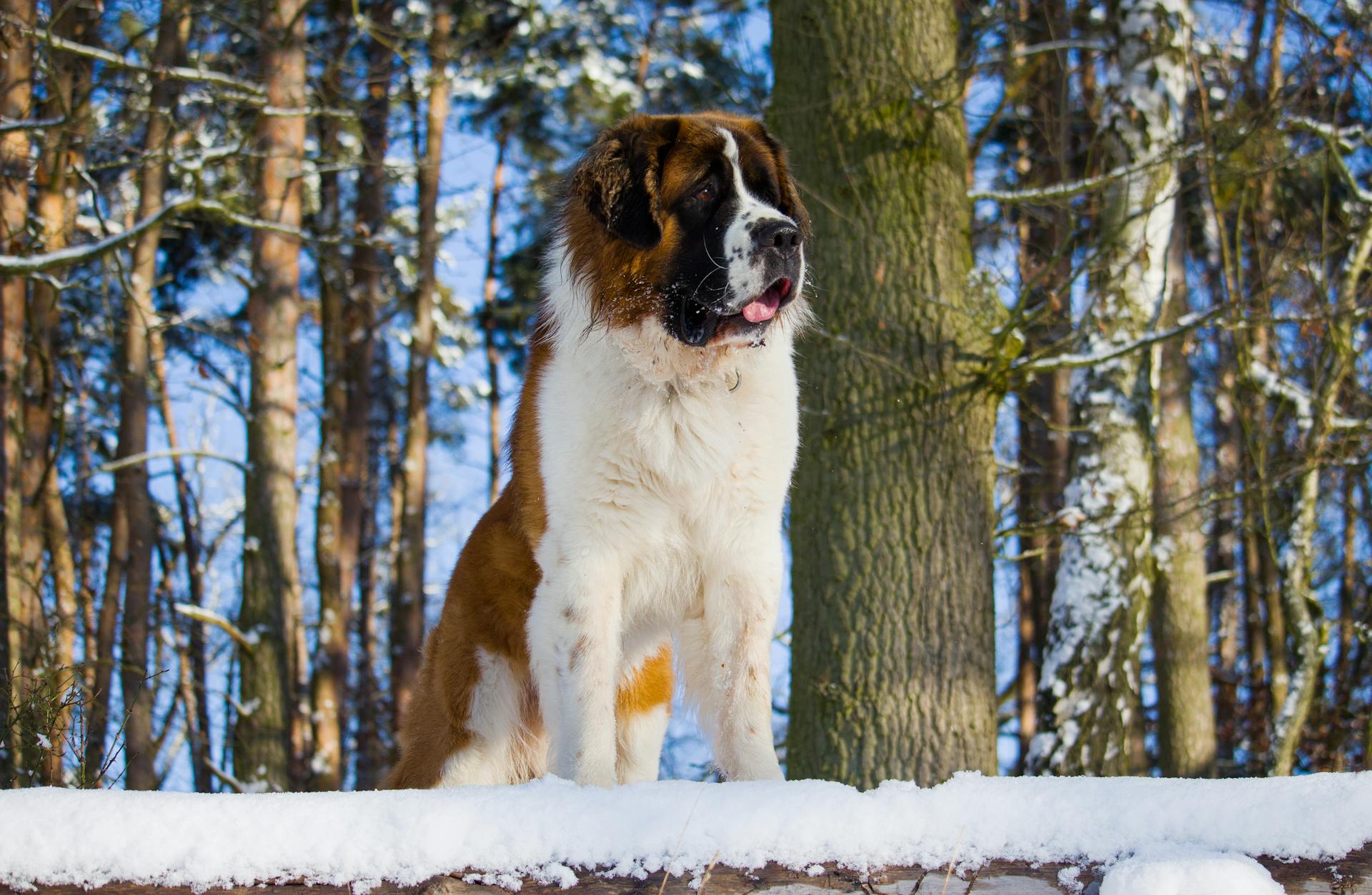
The Saint Berdoodle is a cross between a Saint Bernard and a Poodle, and this unique combination creates a loyal and loving companion.
They typically weigh between 80-120 pounds and stand between 23-27 inches tall.
Saint Berdoodles are known for their low-shedding coat, which requires regular grooming to prevent matting.
With proper training, they can thrive in a variety of living situations, from apartments to homes with yards.
Their intelligence and trainability make them a great choice for first-time dog owners.
Breed Characteristics
Saint Berdoodles can reach a maximum size of 24 to 30 inches in height and weigh up to 200 pounds as adults.
They come in a variety of colors including white, black, cream, brown, silver, red, and blue, as well as cafe au lait and mixed color coats.
A Saint Berpoo's lifespan is 10 to 12 years, but with proper care, it can increase.
This breed is large, so it's essential to supervise young children and small pets when they're around.
Saint Berdoodles are people-oriented and enjoy being with company, but they can become clingy and needy if left alone for too long.
They're generally tolerant of children and pets, but socialization from an early age is crucial to ensure they get along well.
Saint Berdoodles can be protective and territorial, but this can be trained out of them.
Their gentle nature makes them a great breed for families, but their size requires careful consideration.
Care and Maintenance
To keep your Saint Berdoodle in peak health, regular veterinary check-ups are a must. Annual visits are essential, and additional visits should be scheduled if you notice any health concerns developing.
Saint Berdoodles require daily exercise, which can vary in intensity depending on their individual energy levels. If they inherit the Poodle's high energy, they'll need more physical activity, while those with a Saint Bernard's low energy may tire quickly and need breaks.
A daily walk is a must for your Saint Berdoodle, and regular exercise will help keep them fit and mentally well. This can include walks, playtime with the family, or trips to the dog park. To prevent ear infections, check your Saint Berdoodle's ears regularly for debris, and use a vet-approved solution and cloth for cleaning if needed.
To maintain their coat, Saint Berdoodles require regular brushing. If they inherit the Saint Bernard's coat, regular brushing with a slicker brush will help control shedding. If they inherit the Poodle's coat, professional grooming may be necessary. Regular nail trims are also essential, done approximately once a month or as needed.
Here's a quick guide to Saint Berdoodle grooming:
- Bathing: once a month or as needed
- Ear cleaning: regular checks and vet-approved cleaning solution
- Nail trims: approximately once a month or as needed
- Teeth brushing: two to three times per week
Feeding
A Saint Berdoodle's dietary needs change throughout its life, so it's essential to consult with your veterinarian for personalized recommendations.
Your Saint Berdoodle will need a large breed dog food with medium energy, but you'll need to evaluate your dog's energy level for yourself, as it depends on which parent your dog takes after.
Saint Berdoodles need a lot of food due to their large size, so be prepared to feed them 2,000 or more calories every day or up to five full cups of dry dog food.
You can also try using wet or canned food if your Saint Berdoodle turns its nose up at dry food, but some dogs may never go back to dry food after eating canned food.
Related reading: Saint Bernard Large Dogs

Saint Berdoodles have large appetites, so you'll need to feed them a substantial amount of food, but the exact amount will depend on their size, with a general rule of thumb being 3 to 4.5 cups of dry food per day.
For larger Saint Berdoodles, you'll need to add an extra 1/3 cup of food for every 10lbs over 100lbs of body weight.
Adding freshly cooked veggies or a dog food topper like gravy or broth can be a great way to encourage your fussy Saint Berdoodle to eat.
A mix of dry and wet food can be a good option to ensure your Saint Berdoodle is getting the proper nutrition, especially for giant breeds that are prone to skeletal deformations.
Maintenance
Saint Berdoodles require regular exercise to stay healthy and happy. A daily walk is a must, and they should also have time to play and explore outside.
Their energy levels can vary, but they generally need some time to exercise, play, and nap during the day. A few shorter walks are better than one long walk. They may need to take breaks or naps, especially if they take after their Saint Bernard parent.
Regular nail trims are also important, about once a month, or as needed. You can do this yourself with special trimmers or ask a groomer for help. Their teeth should be brushed two to three times per week.
Their ears need to be checked regularly for debris, and their eyes should be checked every so often to ensure they're clear of infection or debris. Your vet may recommend occasional cleaning with a vet-approved solution and cloth.
To minimize the possibility of infection, it's essential to check their ears and eyes regularly. Regular tooth brushing is also crucial to ensure their long-term dental health.
Here's a quick rundown of the Saint Berdoodle's grooming needs:
Training and Behavior
Training a Saint Berdoodle requires patience and consistency. With their high intelligence and eager-to-please nature, they thrive on positive reinforcement training methods.
Saint Berdoodles are quick learners, but they can be stubborn at times. Incorporating games, puzzles, and rewards into training sessions can help keep them engaged and motivated.
Socialization is key when training a Saint Berdoodle. They love being around people and other animals, but they can become clingy and needy if not properly socialized from an early age.
To prevent destructive behavior, Saint Berdoodles need plenty of mental stimulation. This can be achieved through obedience training, agility training, and interactive puzzle toys.
A daily walk and regular exercise are essential for Saint Berdoodles. They come in a range of sizes, but all require physical activity to stay happy and healthy.
Here are some tips for exercising your Saint Berdoodle:
- Puzzle toys and interactive games can provide mental stimulation and keep them occupied
- Obedience training and agility training can help burn off excess energy
- Teaching new tricks can provide mental stimulation and challenge their intelligence
- A fellow pet to play with can provide companionship and exercise
- Give them a job, such as fetching or carrying items, to provide a sense of purpose
- Create an obstacle course to challenge their physical abilities
- Teach them the names of different toys to provide mental stimulation
Saint Berdoodles are generally good with children and other pets, but they do require supervision due to their large size. With proper training and socialization, they make excellent family pets.
Grooming and Appearance
Saint Berdoodles come in a variety of colors, including white-and-brown, white-and-black, red with white accents, and white with red accents.
Their coats can take after either parent, with some having the wiry and curly coat of the Poodle, while others have the longer and smoother coat of the Saint Bernard.
Saint Berdoodles are generally a lower-maintenance mixed breed, but they still require regular grooming. If they have the curly coat of the Poodle, they won't need frequent brushing, but they will require regular trims at the groomer.
They can weigh anywhere from 45 to 180 pounds and stand between 14 to 30 inches tall from the ground to the top of the shoulders.
Their coat color can be white and brown, white and black, or red and white, and their coat type and texture can be curly, wiry, smooth, bushy, or coarse.
Here are some general grooming guidelines for Saint Berdoodles:
Saint Berdoodles are not hypoallergenic, and they shed significantly throughout the year, especially if they take after their Saint Bernard parent.
Size
Saint Berdoodles are generally larger dogs, with a weight range of 40-180 pounds, depending on the size of the Saint Bernard parent.
The smallest Saint Berdoodle you're likely to find would weigh around 40 pounds, which is on the lower end of a female Standard Poodle's weight range.
A male Saint Berdoodle typically starts at 50 pounds.
In terms of height, Saint Berdoodles can range from 15 to 30 inches tall.
Curious to learn more? Check out: Saint Berdoodle Weight
Health and Grooming
Saint Berdoodles are generally a healthy breed, but like all breeds, they can be prone to certain health issues. Regular veterinary check-ups and proper care can help prevent or manage these issues.
Hip Dysplasia is a common skeletal condition that can cause instability and arthritis in Saint Berdoodles. Ear Infections are also a concern, and can be caused by bacteria or yeast.
Saint Berdoodles can inherit health issues from their parent breeds, including Wobbler Syndrome, Bloat, Skin Problems, and Von Willebrand's Disease. It's essential to monitor your Saint Berdoodle's health and seek veterinary care if you notice any unusual symptoms.
Here are some common health issues that can affect Saint Berdoodles:
- Hip Dysplasia
- Ear Infections
- Wobbler Syndrome
- Bloat
- Skin Problems
- Von Willebrand's Disease
In terms of grooming, Saint Berdoodles require regular brushing to prevent matting and tangling. If they have a curly coat, they may require less frequent brushing, but regular trims at the groomer are still necessary.
Bathing should be done about once a month, or as needed. Saint Berdoodles are generally well-equipped for cold weather, but may not tolerate high heat well.
Here's a rough guide to Saint Berdoodle grooming needs:
Saint Berdoodles can inherit a range of coat types and textures from their parent breeds, including curly, wiry, smooth, bushy, and coarse. Regular grooming can help prevent shedding and matting, and keep your Saint Berdoodle looking its best.
Purchasing and Ownership
Purchasing a Saint Berdoodle can be a significant investment, with prices ranging from $1,000 to $5,000, depending on factors such as bloodline, breeder reputation, and location.
Saint Berdoodles are a cross between a Saint Bernard and a Poodle, and as such, they require regular grooming to prevent matting and tangling of their fur, which can be time-consuming and expensive.
If you're considering purchasing a Saint Berdoodle, be prepared to spend at least 30 minutes per day on grooming, or consider hiring a professional groomer to do it for you.
Where to Get

If you're considering bringing a Saint Berdoodle into your family, you'll want to know where to get one. You may be able to find a Saint Berdoodle through a breed-specific rescue, but it may be harder to find one than a purebred Saint Bernard or Poodle.
You can try contacting Saint Bernard or Poodle breed-specific rescues, as they often care for mixes. Colorado Saint Bernard Rescue, for example, may have Saint Berdoodles available for adoption.
If you're having trouble finding a Saint Berdoodle rescue, you can also try contacting the Saint Bernard Rescue Network. They may be able to connect you with a Saint Berdoodle in need of a new home.
Here are some rescues you can try:
- Colorado Saint Bernard Rescue
- Carolina Poodle Rescue
- Saint Bernard Rescue Network
Cost Estimate
Purchasing a Saint Berdoodle can be a significant investment. Saint Berdoodle puppies can cost between $1,000-$2,000 depending on their parentage.
If the parents are registered with the AKC, the price can be as much as double.
Designer Dogs
Designer dogs are a relatively recent phenomenon, with the first mixed breed puppies appearing in the United States in the 1980s.
The Saint Berdoodle is a popular designer breed, created by combining Poodles and St. Bernards.
The American Kennel Club does not officially recognize the Saint Berdoodle, unlike the American Canine Hybrid Club and the Designer Dogs Kennel Club.
You won't find any rescue groups specifically dedicated to the Saint Berdoodle, but you might find some Poodles and St. Bernards in rescue groups that need homes.
The Saint Berdoodle's rarity makes it a unique addition to any family.
Similar Breeds and Information
If you're considering bringing a Saint Berdoodle into your family, you might be wondering about other breeds that share similarities with this lovable mix.
The Saint Berdoodle's Poodle parentage means they often inherit the low-shedding, hypoallergenic coat of their Poodle side.
Their Saint Bernard heritage also contributes to their large size and gentle nature.
The Saint Berdoodle's friendly, outgoing personality is reminiscent of the Golden Retriever breed, which is known for its affectionate and social nature.
Their intelligence and trainability are also similar to those of the Poodle breed, making them highly trainable with positive reinforcement.
Their Saint Bernard side also means they often inherit the breed's calm and patient demeanor, making them a great fit for families with children.
Health
A Saint Berdoodle's health is generally good, but they can inherit health problems from their parent breeds. They can live between 10 to 12 years.
Hip dysplasia is a common health issue in Saint Berdoodles, where the hip joint doesn't develop properly, leading to instability and potential arthritis. It's essential to keep an eye on your Saint Berdoodle's joints and take them to the vet for regular check-ups.
Bloat, also known as Gastric Dilatation-Volvulus (GDV), is a life-threatening condition where the stomach fills with gas and twists, cutting off blood flow and leading to shock. If you notice your Saint Berdoodle exhibiting symptoms after eating, such as uncontrollable panting, gas, pain, and distention in the stomach, seek veterinary attention immediately.
Ear infections are also common in Saint Berdoodles, especially due to their large and floppy ears. Regular ear cleaning and inspections can help prevent infections.
Some other health issues that may affect Saint Berdoodles include:
- Hip/Elbow Dysplasia
- Gastric Dilatation Volvulus (GDV)
- Arthritis
- Heart Disease
- Entropion
- Ectropion
- Addison's Disease (AD)
- Epilepsy
It's essential to monitor your Saint Berdoodle's health and address any issues promptly to ensure they live a happy and healthy life. Regular veterinary check-ups and a balanced diet can help prevent many of these health issues.
Frequently Asked Questions
Are Saint Berdoodles good pets?
Saint Berdoodles are known for their calm, protective nature and high trainability, making them a great choice for families and first-time pet owners. With proper care and attention, they can form strong bonds with their owners, becoming loving and loyal companions.
Is a Saint Berdoodle hypoallergenic?
Yes, Saint Berdoodles have a hypoallergenic coat, making them a great choice for families with allergies.
Do Saint Berdoodles bark a lot?
No, Saint Berdoodles are known to be quiet dogs with minimal barking. They may have occasional outbursts of social behavior, but overall they are relatively calm and quiet companions.
Do St. Berdoodles drool?
St. Berdoodles are less likely to drool due to their reduced slobbery jowls and droopy eyes. However, they still retain the Saint Bernard's signature "soppy face
What's the difference between Bernedoodle and Saint Bernedoodle?
Bernedoodles are ideal for families seeking a smaller dog with varied coat colors, while Saint Bernedoodles are best suited for those wanting a large, calm companion
Featured Images: pexels.com

